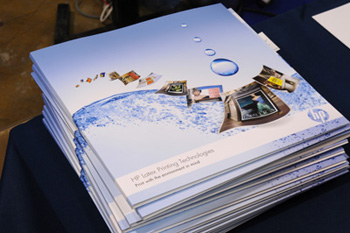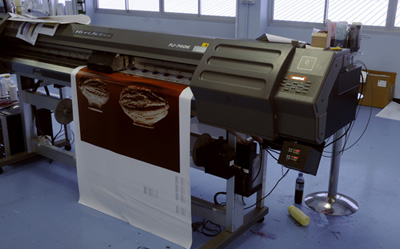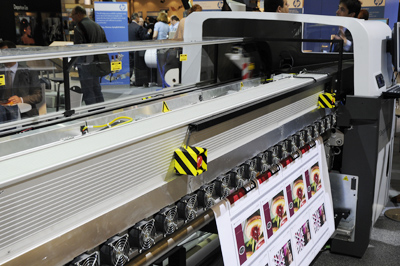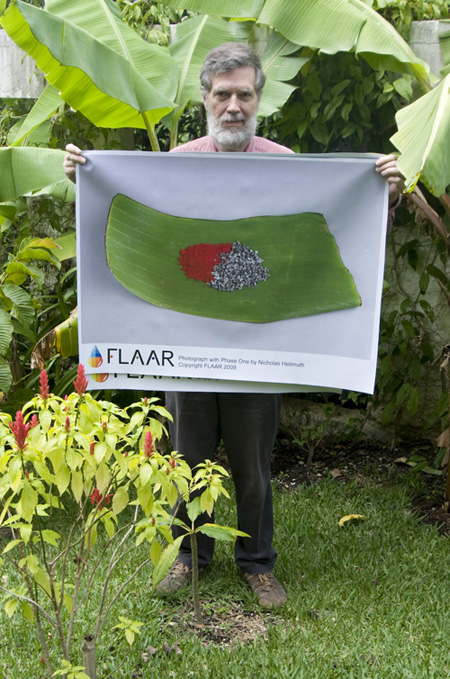HP Latex printers are Designjet but a lot of input from HP Scitex
HP Scitex is the heavy-duty production side of HP. The present latex printer is in the HP Designjet family, not the Scitex brand name, but HP Scitex technology is evident in the robust construction of the frame and chassis. You can see the experience of HP Scitex in the new dual-roll capability unveiled at ISA sign expo 2010.
 |
HP Latex Ink samples |
HP Latex inks with HP wide scan printing technologies
Now that the HP latex ink chemistry has been announced to the public, more people are asking about the reality of this latex resin ink. Indeed there are other new ink announcements by other companies as well (being a professor tends to mean that we find out about things early, plus we can generally estimate that needs to be developed anyway, using common sense).
HP states adamantly that their latex ink is not an ink like the vinyl jet (an ink reportedly from DuPont, used in the failed Encad VinylJet). But another ink chemist questions this and now a second ink chemist has raised the same question: to what degree is latex ink of 2008 a relative of VinylJet ink of many years ago? This also reminds us that most other innovative inks require a heater such as Lumocolor, by Staedtler (formerly one of our favorite inks).
 |
This sample is printed with an after-market "latex ink" that attempts to emulate at least some of the properties of the HP latex ink. But this third-party latex ink does not require a special heating system; it can do okay with the ordinary heating system that is already on a normal solvent printer such as Roland, Mimaki, or Mutoh. I found this latex ink in the beta-test site for this ink company; I was not visiting the printshop to look for latex ink; I was here to inspect a UV-curable inkjet printer. But in another room I noticed an uncommon ink, I asked about it, and was told it was the first after-market latex ink, with the important feature that it does not require any new printer. Of course it is unlikely this third-party solution offers the finesse of the HP system, but it costs $100,000 less, so is more palatable for clients in countries that can't afford a hundred-thousand dollar printer. Recently, a senior manager from one of the solvent printer companies told me that HP latex ink works acceptably in a normal solvent printer, without any furnace-like heating blast to cure it. So it will be interesting to see how Mimaki, Mutoh, and Roland react to the success of HP latex ink. |
There is also another unusual and atypical ink, Magic Ink by Eastech. But this ink has not yet been commercially successful and is not easily available in the US or Europe. Besides there are several newer inks from other sources that appear to be better than Magic Ink (such as Sepiax). If you read between the lines on FLAAR reports during 2009 (if you order the new reports called “TRENDS” from www.wide-format-printers.NET; go to the links at the right to UV); if you get all the TRENDS reports you will see what new inks we are alluding to here.
It took over a year, but finally it was possible to inspect a major printing company that had an HP latex ink printer in action: the HP Designjet 65500. They had the printer only a few months, so next September I will ask how it is working after a year (I visit Johannesburg every year to lecture at SignAfrica).
During DRUPA 2008 I kept track of:
- Whether other competing companies were even worrying about latex ink
- Questions and uncertainties about HP latex ink
Most other companies were not concerned and had no plans to introduce printers in the direction of latex ink. As is not surprising, I found the usual mis-information and confusion that would be expected for any new ink. But without more factual data (information that I myself obtain, not from the endless Tsunami of PR releases from the distributor (in this case HP)). But I can definitely say that despite all the PR released by PR agencies on HP latex ink, it remains the most misunderstood wide-format ink of all times. All this is typical of any situation where there is a lack of available facts other than the deluge of PR releases, so all kinds of rumors fill the industry rumor mill, especially at a trade show like DRUPA.
Of course when there is uncertainty and confusion, this is an ideal place for FLAAR to prepare a summary and put the facts in order. Unfortunately we have so many other research projects that latex ink did not get any budget last year.
|
That was the situation at DRUPA 2008 ; not much buzz on latex ink really. More people were looking for UV-cured printers and everyone else was content with eco-solvent, mild-solvent, and even still full solvent printers. Actually it was a comparable situation all the way through FESPA 2009 (early summer). Indeed FLAAR initiated a project on mild-solvent inks to study the new Seiko ColorPainter H-104s.
Nothing changed much over the summer, but then at VISCOM Duesseldorf '09 in October and the following week at SGIA in New Orleans the two newer HP Designjet L25500 models came out. Finally printshop owners realized there might be something worth at least asking whether these inks could really compete with eco-solvent and mild-solvent.
HP latex ink compared with Sepiax water-based resin ink
But then in 2010 a new resin ink came out: Sepiax ink. This is water-based, resin chemistry. FLAAR has been studying this ink for two years now. First we went to the R&D and demo rooms of the Sepiax ink in Austria. As a result of the FLAAR articles and preliminary reports, distributors reacted positively and country after country signed up to make this ink available around the world. So now we have feedback from early adapters. So the new FLAAR Reports on Sepiax resin ink compared with HP Latex resin ink will be out by May 2010.
It is ironic that originally I planned to have an HP latex ink project. But HP never followed through with bringing me to contact with beta testers, so when I noticed that Sepiax ink was open to discussion and to train me in their ink, this new ink seemed easier to work with, so I started a long-term Sepiax ink evaluation project.
After HP latex inks were introduced there was no access to do test printing (until 14 months later). So, in the meantime, while I was doing a site-visit test study of a UV-curable inkjet printer in another city, I saw another printer using an after-market latex ink. This was a normal Roland eco-solvent printer, with no change in hardware, simply with third-party alternative latex ink. This means that if you wish latex ink you can simply add it to your Mutoh, Mimaki, Roland, DGI or other eco-solvent, mild-solvent, or lite-solvent printer.
Since access turned out to be easier to this after-market latex ink usage, I will learn more about it and update the FLAAR reports. A lot of our readers ask us about alternative third-party after-market solvent inks. I stayed away from this subject for many years, but after I noticed that all the magazines were recommending after-market inks I began to take a look myself. I recently visited the factory of InkWin, and then visited their ink test labs: several million dollars worth of testing equipment in more than twelve lab rooms in two buildings.
And I visited the LED-curable UV ink labs of Sun LLC in Russia and ink labs of additional companies in other countries also.
An even more interesting multi-purpose ink is from a new ink lab that I hope to visit later this year (in 2010).
In conclusion: some inks start out with substantial PR: bio-ink was a big splash two or three years ago. But then that fad fizzled rather quickly. Although (Mutoh) bio-solvent inks are still being touted in PR releases, and although obviously some printshops do use them, they are not catching on as much as industry analysts would have expected considering the volume of PR cranked up when these inks were launched.
One aspect of latex ink is the difficulty in obtaining unbiased independent information on it. At least on cationic UV ink it has been possible to learn about this ink because it is now widely used (in the Gerber Solara ion). Over 200 units are available to inspect.
But latex ink has several advantages over MuBIO bio-solvent ink: namely a substantial team of experienced engineers who have built an entire program around the future potential of latex ink. It is also nice to see new technology developed around a thermal printhead (which documents that thermal printheads do have potential when compared with piezo heads).
 |
HP Latex Ink event at HP-Scitex in Israel, attended by Professor Nicholas Hellmuth.
|
What can HP latex inks handle? Are they only for billboards and banners? What about vehicle wrap?
At SGIA '09, there were more questions than answers. The heading above abbreviates some of the questions. So this is the next phase of my project, to learn, from site-visit case studies in actual printshops, what HP latex ink can truly accomplish. This is crucial since at SGIA ‘09 the manufacturers and distributors of eco-solvent printers began asking pointed questions about everything that perhaps latex ink might not accomplish. These kinds of questions are logical when a disruptive technology suddenly appears. At ISA 2010 the static (the critique) about latex ink had increased, as more end-users “bought into” the green solution but found that merely being labeled as green did not necessarily produce a system that was realistic in a printshop that needed to constantly satisfy new clients who might ask for special applications that require innovative substrates which can't take the 100 degree Centigrade curing temperatures of HP latex ink.
Kodak and Agfachrome and Fujichrome did not embrace digital photography when it first came out. And, the first digital cameras in the 1990's were so immature they did not last very long (FLAAR kept with darkroom film to 1996; since then we moved to the vanguard of advanced digital photography, as you can see on our www.digital-photography.org).
 |
HP Designjet L65500 with HP latex inks as functioning beta-version wide-format printer at DRUPA 2008.
|
Clearly eco-solvent and mild-solvent still offer features and performance that has advantages. And equally obviously latex ink offers other benefits. Not many people would claim that one is perfect and that the other is unusable. But the question is to approach this from a neutral perspective that is fair to both sides. Here FLAAR has an advantage since we have over 411, 000 readers in the area of solvent and UV (and a million readers still interested in water-based printers for photography, giclee, textiles, and indoor signage).
FLAAR has been working during 2004-2010 primarily on UV-cured systems. But every year we add additional coverage to assist printshop owners and managers obtain factual information with realistic pros and cons of each technology. So last year we started to evaluate flatbed XY cutters for thick and rigid materials ( Kongsberg cutters, for example), and we have several projects on new inks (yes, inks even newer than latex, such as Sepiax ink).
The obvious surge in questions about latex ink at SGIA 2009 definitely raises our antennae, so we have been adding discussions on latex ink as opportunities to visit end-users become available. And we are not looking for a “Success Story” kind of PR release. No, that is not our style. Printshop owners are asking for actual factual answers on HP latex ink.
 |
Sample photograph printed on the HP Designjet L65500 latex ink printer at SignAfrica trade show, Johannesburg (where Nicholas lectures for three days every year ). The image is of indigenous Maya colorants, in this case from the cochineal insect. This red color is used in lipstick all over the world (not many women realize their red color comes from the female scale insect of the cactus plant; this red color is native to Guatemala and Mexico and was used by the Maya and Aztecs as a colorant for thousands of years). Nicholas is holding the HP latex ink print in his Mayan ethnobotanical garden in Guatemala, Central America. FLAAR is also studying colorants: why did the 6 th century Maya have pigments that lasted over a thousand years when inkjet pigments today last only about one to three years? |
More FLAAR Reports on HP latex ink coming during Summer 2010
It took a long time to obtain factual information on the reality of HP latex ink, but now FLAAR has the pertinent facts, plus we have spoken with several owners of latex ink printers. FLAAR has visited actual printshop that uses HP latex ink printers, and we have printed our own samples with HP latex ink.
More importantly, an increasing number of our readers are writing us directly to ask whether they too should consider HP latex ink, or Sepiax ink or other of the innovative new inks that are gradually replacing eco-solvent. So look forward to new FLAAR Reports on these subjects during the busy international trade show season during Summer 2010.
Most recently updated April 23, 2010.
First posted March 10, 2008. Updated March 18, 2008, July 29, 2008, December 1, 2008, and January 29, 2009. Updated October 14, 2009, after SGIA. Updated March 2, 2010.
